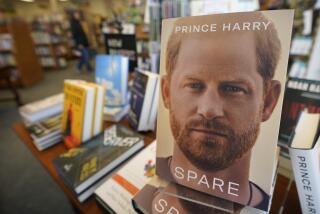Horse comes out a winner
Life, it’s been truly said, has more imagination than we do, and the astonishing story of Seabiscuit proves that absolutely.
No novelist or screenwriter would dare come up with the phenomenal incidents and flabbergasting twists of fate that marked the life of this, the original little horse that could, events that turned a disgraced animal nobody wanted into, author Laura Hillenbrand claims, “the subject of the most newspaper column inches in 1938 ... the year’s number one newsmaker,” besting Hitler, Mussolini, FDR and even Clark Gable.
For the record:
12:00 a.m. July 26, 2003 For The Record
Los Angeles Times Saturday July 26, 2003 Home Edition Main News Part A Page 2 National Desk 0 inches; 27 words Type of Material: Correction
Movie scene location -- A review of “Seabiscuit” in Friday’s Calendar incorrectly described one of the movie’s races as taking place in Acapulco. It was in Tijuana.
The saga of Seabiscuit resonated then as now because it’s not just the story of a horse -- albeit an animal with more personality than many people -- whose encounter with War Admiral, an equine Darth Vader, is still considered the greatest race in thoroughbred history. It was heard on the radio by one out of every three Americans, including President Franklin Roosevelt, who kept advisors waiting so he could listen.
Seabiscuit’s tale is also that of the most improbable of trios, owner Charles Howard, trainer Tom Smith and jockey Johnny “Red” Pollard, three troubled, almost broken men who came together as if it had been preordained, as if they were the reunited pieces of a long-shattered mold. “Recognizing the talent dormant in the horse and in one another,” Hillenbrand writes, “they began a rehabilitation of Seabiscuit that would lift him, and them, from obscurity.”
But what happens when a story that seems made for the movies actually gets turned into one? Can Hollywood improve on or even do justice to a tale whose indisputably real events sound as if they were dreamed up expressly for the screen? How do you print the truth, to paraphrase the famous line from “The Man Who Shot Liberty Valance,” so that it doesn’t feel like a legend?
That’s the challenge met with uneven results by “Seabiscuit,” written and directed by Gary Ross from Hillenbrand’s exceptional book, a deserved fixture on bestseller lists for nearly two years. It’s an honorable effort, best when the horses are on the screen, less sure-footed with its humans and fated to find more favor with newcomers who have not read Hillenbrand’s book or seen the excellent PBS documentary. The film’s great frustration is that it has taken this superb true story and made it feel too much like a movie. A well-crafted movie, but a movie nevertheless.
Given how profligate with dramatic events the fates were with Seabiscuit, it’s not in the cards for any one motion picture to fit in all those incidents. Even at a running time of 2 hours and 21 minutes, the film leaves out memorable things, including one of the horse’s three epochal runs in the Santa Anita Handicap and some of the tragedies that marred jockey Pollard’s startling life. The book’s fans will miss the full dramatic arc, the rich texture of reality the movie lacks, but to a certain extent that may have been unavoidable.
What “Seabiscuit” does find time for is a self-conscious attempt to place the horse in the context of its time, as Ross makes extensive use of voice-over to open the story and to gradually broaden its scope as it unfolds.
Employing vintage black-and-white photographs and narration read by historian David McCullough, “Seabiscuit” uses lines like “for the first time in a long time, someone cared” to explicitly connect the way the country’s spirits were raised both by the New Deal and by a horse newspapers were calling “America’s ultra-ultra equine.”
This is a good idea, but the film relies on it too often. And McCullough’s voice, which practically screams “PBS documentary,” is an intrusive distraction from another medium that detracts from the story and underlines the obvious in a way other parts of the film come to echo.
What is most cinematic, and most successful, about “Seabiscuit” is the way its numerous horse races were designed (by former jockey Chris McCarron, winner of 7,141 races over 28 years), photographed (by John Schwartzman) and edited (by William Goldenberg).
According to the press material, director Ross, a horseracing fan, held a race meeting every morning at 11 for two months before the start of shooting. It was time exceptionally well spent, as the film, using resources ranging from a mechanical mount known as an equicizer to a specially built camera car called the Mobile Technocrane Vehicle to 50 real horses (including 10 standing in for the Biscuit), beautifully re-creates everything from Acapulco’s brutal racing scene to that celebrated match race. Placing us on the track, making us viscerally feel what those races were like with 1,000-plus-pound animals thundering along at 40 miles per hour, is something film can do better than any other medium, and it’s hard to imagine it being done better than it is here.
It’s at least an hour before Seabiscuit appears in his own film, and that time is taken up cross-cutting among the stories of the three men who will steer his fate.
Howard (Jeff Bridges) is introduced first, an entrepreneurial young man who arrived in San Francisco with the proverbial 21 cents in his pocket and ended up one of the country’s wealthiest automobile distributors. Played by Bridges with a heartiness a bit too reminiscent of his work in “Tucker,” Howard begins by saying, “I wouldn’t spend more than $5 on the best horse in America” and ends up, through a combination of tragedy, happenstance and the encouragement of his wife (Elizabeth Banks), being Seabiscuit’s owner.
About the horse’s trainer, Smith, described by a reporter as someone who “says almost nothing, constantly,” a lot less is known. Nicely played by Chris Cooper, who knows how to do taciturn, Smith was the original horse whisperer, a font of ancient equine wisdom who was much more at ease with animals than he ever was with humans.
The last piece of the puzzle was Pollard, a journeyman jockey who had a 6% winning percentage before he hooked up with the horse he called “Pops.” Tobey Maguire with dyed hair captures the resilient toughness and the sentiment of this unlikely hero, a man who loved poetry, hated to lose and had secrets of his own. It isn’t the actor’s fault that Maguire lacks Pollard’s haunted look, a product of alcoholism (which the film doesn’t mention) and hard knocks that made the jockey look 50 while he was still in his 20s. The ups and downs these men share with a horse the racing establishment had written off as lazy and incorrigible will not be revealed here, but they all point to a theme articulated more than once by Howard.
“You don’t throw a whole life away because he’s banged up a little,” he says at one point, echoing Tom Smith, then adding later: “Sometimes all somebody needs is a second chance. A lot of people out there know what I mean.”
If “Seabiscuit” has a problem, it’s visible in those phrases and others like it. They’re too much on the nose, they push a good idea a little too hard, they soften and Hollywoodize an already emotional story in ways that are counterproductive. When added to the old-fashioned glossiness of the cinematography and the sentiment inherent in Randy Newman’s music, they make a story that actually happened seem somehow less than real.
With a tale so emotional it just about makes you weep, what’s needed is not the little extra nudge it gets here but a more pulled-back, levelheaded sensibility, a contrasting cool grittiness that would increase the story’s effectiveness by reminding us that it is the truth. What “Seabiscuit” wants is more of the sense of dramatic authenticity brought by the casting of three-time Kentucky Derby-winning jockey Gary Stevens as Pollard’s fellow jock George Woolf and less of the hokum typified by William H. Macy as the cutesy composite radio announcer “Tick-Tock” McGlaughlin.
Yet it can also be argued that like Seabiscuit himself, who often did better than expected despite carrying more weight than his competitors, this film does enough things right to survive its missteps. It is not as exceptional a film as the reality deserves, but with a story this strong and races this expertly re-created, it squeezes out a victory by being as good a movie as it needs to be. On some days, that is enough.
*
‘Seabiscuit’
MPAA rating: PG-13, for some sexual situations
and violent sports-related images
Times guidelines: Adult subject matter
Tobey Maguire...Red Pollard
Jeff Bridges...Charles Howard
Chris Cooper...Tom Smith
Elizabeth Banks...Marcella Howard
Gary Stevens...George Woolf
William H. Macy...”Tick-Tock” McGlaughlin
More to Read
Sign up for our Book Club newsletter
Get the latest news, events and more from the Los Angeles Times Book Club, and help us get L.A. reading and talking.
You may occasionally receive promotional content from the Los Angeles Times.






